An Index of How Our Family Was Killed
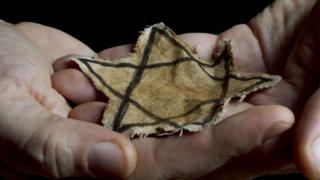 Getty Images
Getty Images
The Holocaust was a period in history during which millions of Jewish people (who Nazis identified using a Star of David, equally seen in this picture) and other people were killed because of their identity
The Holocaust was a period in history at the fourth dimension of World War Two (1939-1945), when millions of Jews were murdered considering of who they were.
The killings were organised by Germany's Nazi political party, led past Adolf Hitler.
Jews were the main target of the Nazis, and the greatest number of victims were Jewish. Nearly 7 out of every 10 Jews in Europe were murdered because of their identity.
The Nazis also killed other groups of people, including Roma ('gypsies') and disabled people. They as well arrested and took abroad the rights of other groups, similar gay people and political opponents. Many of them died as a result of their treatment.
The Holocaust was an example of genocide. Genocide is deliberately killing a large group of people, usually because they are a certain nationality, race or religion.
To enjoy the CBBC Newsround website at its best you will need to have JavaScript turned on.
Who were the Nazis?
Nazis is the shortened name for the National Socialist German language Workers' Political party (NSDAP).
The Nazi political party was a political party in Germany established in 1919 in the aftermath of World War One.
It grew in popularity throughout the 1920s, as the country struggled with the autumn-out of World War One. Germany lost the state of war and was forced to pay a lot of money to the winners.
Many people were poor and there weren't enough jobs to go circular, and one reason many Germans turned to the Nazis was the promise that they would bring about modify.
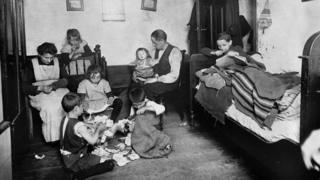 Getty Images
Getty Images
This moving picture shows a poor family unit living in cramped weather in Berlin during the 1920s
Nazis were racist and believed that what they called their Aryan race was more of import than others. The Nazis said an Aryan was somebody Germanic. The Nazis believed that Jews, Roma ('gypsies'), blackness people and other ethnic groups were inferior to Aryans.
Nazis were ruthlessly anti-Semitic and this affected all of their policies and deportment.
They also believed that Germany was a improve state than others and that their people'south superiority meant they could and should dominate other people. This led Federal republic of germany to invade and have over other countries before and during Earth War Two.
Who was Adolf Hitler?
In 1921, a human being called Adolf Hitler became leader of the party.
Then, in January 1933, the Nazis were invited to form a regime subsequently they were voted as the largest party in an election.
From the moment his political party came to power, Adolf Hitler set out to impose Nazi values on all aspects of High german life, taking control using fear and terror.
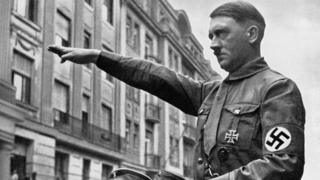 Getty Images
Getty Images
Adolf Hitler set out to impose Nazi values on all aspects of German life
When the German President Hindenburg died in 1934, Hitler declared himself to be the Fuhrer or 'supreme leader of Germany'. (Nowadays, the discussion Fuhrer has a negative pregnant of a ruthless leader who imposes barbarous rule over people.)
The three virtually important things to Hitler and the Nazis were:
- The purity of the Aryan race
- The greatness of Germany
- Idolising the Fuhrer, Adolf Hitler
The political party used lots of propaganda to persuade people to support them. They held big gatherings called rallies, and loudspeakers in public places shouted out Nazi messages.
What was the Holocaust?
The Holocaust was a procedure that started with discrimination confronting Jewish people, and ended with millions of people being killed because of who they were. It was a process that became increasingly brutal over time.
Nazi persecution
From the moment they came to power in 1933, the Nazis persecuted people who they didn't retrieve were worthy members of gild - virtually notably Jewish people.
They introduced laws that discriminated against them and took away their rights. Jewish people were not immune in certain places and were banned from getting certain jobs.
They likewise began to fix concentration camps where they could send people they believed to exist "enemies of the state" to exist imprisoned and forced to work. This included Jewish people and anybody who did not support them.
The first military camp called Dachau was opened in March 1933 just exterior of Munich.
Between 1933 and 1945, the Nazis created more than 40,000 camps in areas they controlled.
Some were work camps, some were transit camps to process prisoners, and others - the outset of which would open in 1941 - would be extermination camps, where the Nazis could kill people in great numbers.
Many people were murdered past military camp guards for no reason and many more died equally a upshot of the terrible atmospheric condition in them.
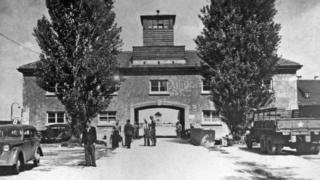 Getty Images
Getty Images
This picture shows the outside of part of Dachau concentration camp
The Nazis also set out to take command of everybody's lives.
In 1934, a law called the Malicious Gossip Law was introduced, which made it a crime to tell an anti-Nazi joke.
Jazz music was banned, textbooks were rewritten to contain Nazi ideas, pictures of Hitler were put up everywhere, and books were destroyed that were not written in means that the Nazis liked.
In 1935, ane,600 newspapers were airtight down and the ones left were only allowed to print articles approved of by the Nazis.
They ready compulsory groups for young people called Hitler Youth (for boys) and BDM (for girls), so they would go young Nazis who idolised Hitler as they grew upwards. Boys were taught Nazi values and prepared for state of war; girls were taught skills like cookery and sewing.
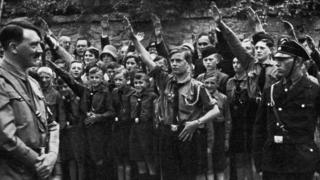 Getty Images
Getty Images
Here, nosotros can see Hitler surveying a group of young Nazi supporters
Kristallnacht and the murder of millions
An important appointment was 9 Nov 1938, when there was a night of terrible violence against Jewish people.
It became known as Kristallnacht - the 'night of cleaved glass' - due to all of the smashed glass that covered the streets from shops that were raided.
90-one Jews were murdered, 30,000 were arrested and sent to concentration camps, and 267 synagogues were destroyed.
On 1 September 1939, Germany invaded in Poland which marked the commencement of Earth War Two.
Jewish people in Poland were forced to live in selected areas called ghettos where they were treated very poorly and many were murdered.
Conditions in the ghettos were very bad, and many lost their lives as a result of affliction and starvation.
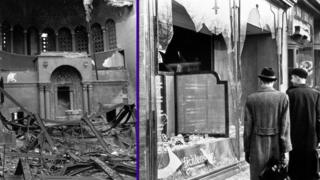 Getty Images
Getty Images
During Kristallnacht, synagogues were destroyed (picture on the left) and shop windows were smashed (equally seen on the correct)
By the early 1940s, the Nazis were looking for a way they could kill a great number people in a curt amount of time in order to get rid of Europe's Jewish population.
They came up with the idea of extermination camps in which they could kill lots of people. This is what they would call 'the last solution'.
By the end of 1941, the offset extermination army camp called Chelmno in Poland had been fix.
There were half-dozen extermination camps in total in areas of Poland controlled past the Nazis: Auschwitz-Birkenau (the largest), Belzec, Chelmno, Majdanek, Sobibor and Treblinka.
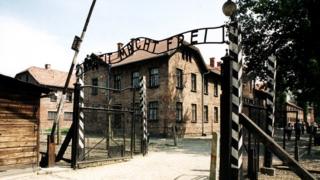 Getty Images
Getty Images
A famous gate at the Auschwitz camp reads 'Arbeit macht frei', which means 'work sets y'all free' in German
Camps were as well established outside of Poland (in Belarus, Serbia, Ukraine and Croatia) by Nazis and their allies, where many hundreds of thousands more died.
Between 1941 and 1945, people were murdered on a scale that the globe had never seen before.
Millions were rounded up and put on trains to the camps, where they would be forced to work or killed.
Who was killed or persecuted in the Holocaust?
Nosotros know that the victims included:
- Jewish people
- Roma and Sinti people ('Gypsies')
- Slavic people, peculiarly in the Soviet Union, Poland and Yugoslavia.
- Disabled people
- Gay people
- Black people
- Jehovah's Witnesses
- Political opponents
How did the Holocaust end?
As soldiers fighting confronting Germany in Globe War Two - Great britain, the US, the Soviet Union and their allies - made their way beyond areas of Europe controlled by the Nazis, they began to discover the camps.
As information technology became clear that the Nazis were going to be defeated, the Nazis tried to hide the bear witness of their crimes past destroying the camps.
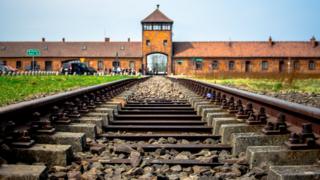 Getty Images
Getty Images
The Nazis tried to hide the evidence of what they had done in the camps
They forced surviving prisoners in Poland to walk back to camps in Germany. Many prisoners lost their lives on these gruelling walks.
The Nazis were not able to hide what they had done, though, and it wasn't long before the globe learned of the extent of the Holocaust.
Majdanek was the first camp to be freed in the summertime of 1944.
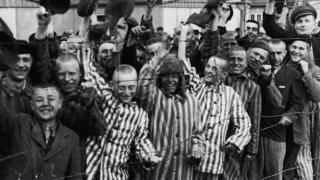 Getty Images
Getty Images
This photo shows prisoners of the Dachau concentration camp cheering at the American soldiers who had come to free them. However, many soldiers spoke of the horrific scenes they witnessed on entering the camps
People who went in to liberate the camps have spoken of the horrific scenes that they encountered.
Many of those who were freed from the camps died fifty-fifty afterwards the liberations as they were and then ill from how they'd been treated.
Life would be extremely difficult even later on the terminate of the state of war.
Many survivors found strangers living in their homes or were unable to observe somewhere they could live.
Countries did not want to welcome such a swell number of refugees.
Were Nazis punished for the Holocaust?
On 11 December 1946, the Full general Assembly of the United Nations ruled that genocide would be a crime under international law.
Adolf Hitler killed himself earlier the end of the war so information technology was non possible to bring him to justice.
In the years since World War Two, Nazi figures have been prosecuted for their crimes.
Even as recently as in July 2015, a German language courtroom convicted 94-year-old Oskar Groening, who was a baby-sit at Auschwitz, for his crimes.
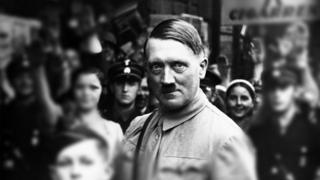 Getty Images
Getty Images
It wasn't possible to bring Adolf Hitler to justice for his crimes considering he killed himself before the cease of Earth War Ii
But it has not been impossible to bring anybody to justice.
Many Nazis went into hiding after the war and were never plant, or have since died earlier their crimes could be found out.
How do we remember the Holocaust?
At present, the enormity of the Holocaust is recognised across the globe and it serves every bit an case of the horrors of genocide and how sure behaviours tin can pb to it happening.
Only, sadly, the Holocaust is non the merely genocide that has happened in history. In Cambodia, Rwanda, Bosnia and Darfur millions of people have been killed considering of who they are.
Every year on 27 January, people in the U.k. marking Holocaust Memorial Day.
It is held on this engagement because this is when the largest Nazi concentration military camp, Auschwitz-Birkenau, was liberated past soldiers of the Soviet Army in 1945.
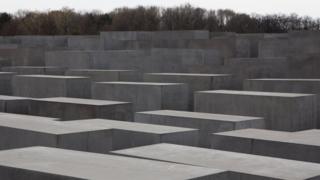 View Pictures
View Pictures
A famous monument in Berlin called the Memorial to the Murdered Jews of Europe allows visitors to take a moment to reflect on the Holocaust
Holocaust Memorial Day is not simply to recall the millions of victims of the Holocaust, but besides those who accept been killed in other genocides around the world.
It highlights how important it is to be tolerant of other people's beliefs and differences, and non to exclude people or spread message of hate.
It also helps us to never forget the events of the Holocaust so that we tin can try to stop anything like it from happening again.
The Holocaust Memorial Day Trust explains how it is a 24-hour interval to "piece of work together to create a safer, better future".
With thank you to the Holocaust Educational Trust
andrewswhostell1946.blogspot.com
Source: https://www.bbc.co.uk/newsround/16690175
0 Response to "An Index of How Our Family Was Killed"
Post a Comment